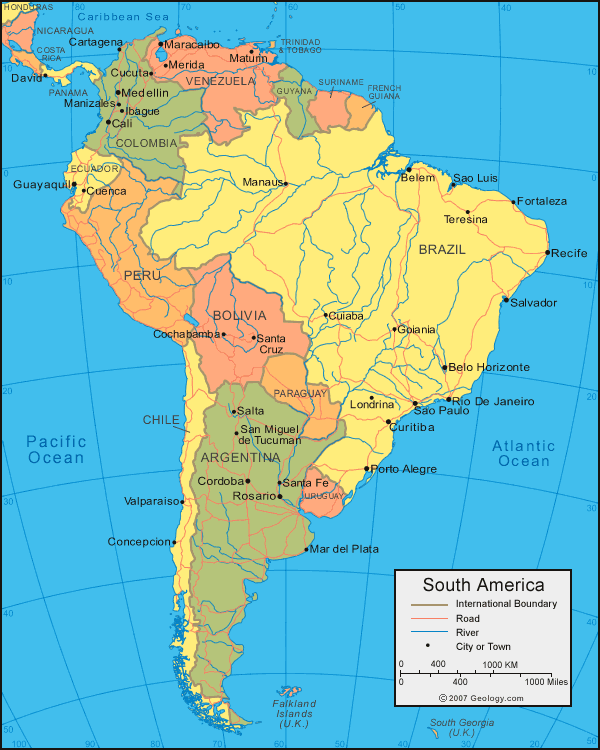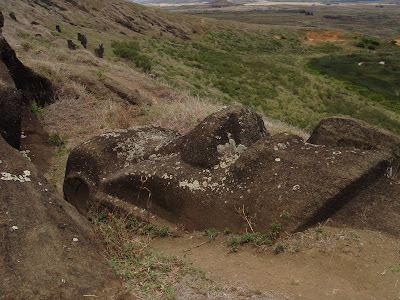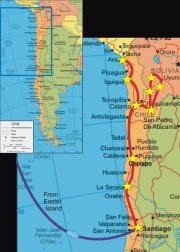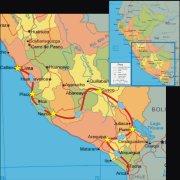Easter Island has to be one of the most remote places in the world. Put it like this – it’s a volcanic isle stranded alone in the middle of the Pacific who’s nearest island neighbour is 1400 miles away! As you wander along the coast here you see a hell of a lot of sea stretching away into the distance. Definitely no land on the horizon! Despite this remoteness, Easter Island has been inhabited for some time by people of Polynesian descent. Their name for the island is ‘Rapa Nui’, which apparently refers to the place being the ‘navel of the world’! And it is of course these people were historically responsible for the most notable features of Easter Island, the Maoi.
What is a Maoi (and how is it pronounced because we never found out!?)? Well, they come in various shapes as sizes, but all are stone statues, carved in a very stylised fashion. They can range from 2 to 20 m high, and are scattered all over the island. How they were moved around and erected, or even carved out of the volcanic rock is largely unknown. But there are over 800 of them scattered around the island, and most are pretty impressive! Have a look at the photos below and you’ll get some sort of an idea we hope. Sadly the people who constructed the Maoi seem to have fallen into warring factions at some point, and so all of the statues that had been lovingly carved, transported around the island and then erected on their platforms were later toppled to the ground. Fortunately many have now been restored to their very impressive erect state!
Anyway, we reached the world’s belly button by a 5 hour flight from Tahiti – on the only plane in or out of the island that day. As you can imagine, the airport was the size of a small garage, and as we exited very sleepily we were swiftly greeted by the owner of our hotel with necklaces of bright yellow flowers. I wish I’d taken a photo of Gary in his fetching traditional necklace, but I was just too tired after missing a night’s sleep to think of it!
After some time to recover we started to explore the island. As we had nine nights here we thought we could see much of the place on foot… or by mountain bike to get to the further bits. And yes, with a bit of effort we managed it! Easter Island is a triangle with its longest side only measuring 15 miles or so. Our guest house was situated on the northern edge of Hanga Roa, the island’s main village, only a few hundred yards from some very impressive Maoi at the Tahai complex. These statues looked particularly nice at sunset, which was unfailingly beautifully colourful each night! So we visited them once or twice…
To see the other features of Easter Island we had to venture a little further a field. One day we wandered in a loop of the northern area of the island to see Ahu Akivi, where seven impressive Maoi stand gazing out towards the sea (unusual – all the other statues look inland to ‘look after the people and island’ apparently). Near here were some caves formed by hot lava draining through holes in the rock. One of these, Ana Kakenga, was great fun, if a bit scary to explore. First you had to squeeze through a small hole in the ground, only about half a meter wide and high. Then you had to scramble along a short stretch of pitch black, uneven tunnel, where the roof was always lower than a meter from the floor – Georg’s torch was really useful here! Fortunately if you survived this cramped section the cave then turned a corner and opened up, giving you a bit more room to breathe. You even had light to navigate the rocky floor and uneven ceiling from openings in the far walls - but we both still managed to bang our heads a few times! Wandering over to the cave openings was well worth it though, as they were situated half way down a shear cliff face, with waves from the Pacific Ocean crashing at its base below!
Another day we decided to walk to Orongo, an ancient village perched on the edge of a huge volcanic crater, Rano Kau. It didn’t seem too far on the map – a 5 mile or so round trip – but unfortunately the map didn’t show gradient! After traipsing to the top of the volcanic crater in the tropical heat we were shattered. Oddly enough we had a friend for the trip. The island is littered with hundreds of stray dogs and wild horses, and for some reason a friendly black mutt decided to come for a walk with us. She literally dogged our trail all the way to the top of the exhausting climb, at which point she dumped us to wander off with another couple!
Despite our tiredness and abandoned state we were glad we had made the climb – Rano Kau crater is stunning. Almost a perfectly circular crater, with the side facing the sea eroded away in a graceful arc. The floor of the crater was weird too – pools of rainwater reflecting the light between clumps of strange raft-like plants. At the far end of the crater rim trail, facing the sea was the ancient village of Orongo, whose 2 foot high stone houses overlook the sea. This place was fascinating too – traditionally it wasn’t lived in for most of the year, but only during the festival of the ‘Bird Man’. This frankly bizarre event occurred each year to select the sacred ‘Bird Man’ from the leaders of the tribes around the island. Each leader had to choose a man from his tribe to find the first egg of the year laid by a specific migratory bird (the Sooty Tern). Not too difficult? Erm, well, unfortunately the birds only nested on an islet several hundred meters north of the coast by Orongo, so the poor egg-finders had to first scale the sheer hundred meter volcanic cliffs, swim the rough, shark-infested Pacific waters, and then camp on the teeny weenie islet for weeks waiting for the terns to fly in, nest, and (hopefully) lay their precious eggs! Not a hot job. While these poor sods risked their necks the leaders of the various tribes would wait in Orongo, in their nice cosy houses, probably feasting and having a great time. But the winning tribe leader wouldn’t be in for a fun year. Once the first egg was found and the leader of that tribe anointed ‘Bird Man’, that poor sod had to have all his hair shaved off (including eyelashes and eyebrows) before being whisked away to live in complete isolation for one year – during which time he wouldn’t be allowed to bathe or cut his hair or nails! For this year his family would enjoy several privileges however… why do I get the feeling this crazy thing was invented by the wives of particularly irritating tribal leaders…?! Pity the men who went along with it!
But perhaps our best day on Easter Island was the day we decided to tackle the South East Circuit of the island by mountain bike. After thoroughly misreading the Rough Guide, we thought that the best Maoi sites on the island would be easily reachable by bike in a day. After all, there was even a convenient set of roads to follow on a loop along the south coast, then back north-west to Hanga Roa. No problem. Erm, yes.
Well, in practice we did see some amazing things. And most of the cycling was fun – neither of us had been on a bike since we were students! The only slight problem was the distance. We ended up cycling nearly 50 km (over 30 miles)! And not all the roads were particularly friendly – there were long sections of dirt tracks with big stones all over the place. And very big hills, especially on the way back home when we were tired and could have done without them! Ah well, as I said we saw some truly amazing things, and on the whole enjoyed it. We just passed out pretty quickly when we got home, and slept like the dead after a well deserved Mexican meal and margarita!
If you travel from west to east along the south coast of Easter Island, you first come across many Maoi and platforms. Unfortunately all were toppled at the time of war on the island, and have not yet been restored. The giant statues look very sad and forlorn as they rest along side their platforms, some with their red top-hats near by. It is a truly mournful sight! Fortunately further along the route at the eastern side of the island is Tongariki, where fifteen huge and beautifully restored Maoi stand side by side on their 200 m long platform. They are a truly magnificent sight with the sea and some volcanic cliffs as a backdrop.
But Tongariki is actually a good deal less fascinating than the adjacent volcanic crater, Rano Raraku. This would be beautiful in it natural state: a sheer lava cliff forms one side of the crater, while the remainder of the graceful curve consists of red-yellow soil, and a reed-lined lake fills the circular floor. But the fascinating thing about Rano Raraku is that it was the site of the Maoi quarry. The monolithic statues were carved here in all their glory, and then transported to other parts of the island. And over 400 of them still remain! Actually, the most impressive Maoi we saw were here - huge ones - the largest about 20 m long! Presumably work ceased when war broke out amongst the various Easter Island tribes, leaving the Maoi in various stages of progress. Some were still actually attached to the rock-faces they were sculpted from, whereas others had been moved into pits around the base of the volcano, where their huge faces seem to leer at visitors. It is impossible to describe the scale of the place – we were astonished and wandered around for hours.
Anyway, tomorrow we leave for Chile mainland, where we will spend Christmas in Santiago. So if we don’t speak to you all before then have a very Merry Christmas and Happy New Year!
December 2008 - Feburay 2009

Route: Tahiti --- Easter Island (more paradise in the middle of the ocean). Easter Island --- Santiago (then travel overland - don't ask me how - to Lima in Peru, seeing the Inca trail of course). Lima --- Mexico City (have fun in Mexico for a few weeks - including my 30th birthday party). Mexico City --- London
21 December 2008
Easter Island
18 December 2008
Easter Island Photos
 Sunset over the vast Pacific Ocean, with a few beautiful Maoi in the foreground! These ones were a mere 5 minute walk from our Residencial.
Sunset over the vast Pacific Ocean, with a few beautiful Maoi in the foreground! These ones were a mere 5 minute walk from our Residencial. Ahu Akivi - seven beautifully restored Maoi which unusually rested inland and faced out to the sea. They were very impressive all lined up and vertical - it´s such a shame that most are sadly unrestored and lie toppled near their podiums.
Ahu Akivi - seven beautifully restored Maoi which unusually rested inland and faced out to the sea. They were very impressive all lined up and vertical - it´s such a shame that most are sadly unrestored and lie toppled near their podiums. Gary in a lava tube! This dramatic cave was formed when the lava running through it drained away, as the rock above had already solidified. There were loads around this island - this one opened spectacularly (behind me as I took the photo) half way down a cliff over the crashing waves of the Pacific. And below you´ll see Gary again - this time on the outside by the rugged volcanic coastline!
Gary in a lava tube! This dramatic cave was formed when the lava running through it drained away, as the rock above had already solidified. There were loads around this island - this one opened spectacularly (behind me as I took the photo) half way down a cliff over the crashing waves of the Pacific. And below you´ll see Gary again - this time on the outside by the rugged volcanic coastline!
 This is the Mirador Crater at the South West corner of the island. On it´s far rim stands the village of Orongo (where they held the weird Bird Man contest... read the main text above for details!). The floor of the crater was stunning: loads of pools of water reflecting the light, separated by strange matt-like plantation. Bleak but beautiful!
This is the Mirador Crater at the South West corner of the island. On it´s far rim stands the village of Orongo (where they held the weird Bird Man contest... read the main text above for details!). The floor of the crater was stunning: loads of pools of water reflecting the light, separated by strange matt-like plantation. Bleak but beautiful! The islets off Orongo... where the poor men who were nominated to find the egg of the sooty tern had to climb down to, swim to (avoiding sharks) and then somehow survive on for weeks! They don´t look too appealing eh? Crazy!
The islets off Orongo... where the poor men who were nominated to find the egg of the sooty tern had to climb down to, swim to (avoiding sharks) and then somehow survive on for weeks! They don´t look too appealing eh? Crazy! A fantastic view of the impressive 15 Maoi at Tongariki, with yet more volcanic cliffs in the background. The Moai here really were stunning - they were in great condition and of course there were lots of them!
A fantastic view of the impressive 15 Maoi at Tongariki, with yet more volcanic cliffs in the background. The Moai here really were stunning - they were in great condition and of course there were lots of them! This is the volcanic crater from which the Maoi were carved. It was lovely in it´s own right as you can see - red-yellow earth lining a reed-filled lake. But the special bit was behind me as I took this photo... have a look at the next few photos to see what I mean.
This is the volcanic crater from which the Maoi were carved. It was lovely in it´s own right as you can see - red-yellow earth lining a reed-filled lake. But the special bit was behind me as I took this photo... have a look at the next few photos to see what I mean. This huge Maoi unfortunately never made it past the carving stage. This is how they were made: carved in detail from the mountian, and then moved (somehow) about the island.
This huge Maoi unfortunately never made it past the carving stage. This is how they were made: carved in detail from the mountian, and then moved (somehow) about the island. This Maoi was high above the crater floor, and must have been nearly completed when the work stopped as he had really detailed features! Sad that he never got to stand on the coast line somewhere, although he was so big that I haven´t a clue how they would have moved him there! Below you can see some Maoi that made it a little bit futher. There were hundreds of these heads dotted around the volcanic mountain, probably waiting to be moved to their platforms. But these were the most impressive Maoi we saw anywhere on the island. They were huge (the ones in the photo were well over 10 m tall) and beautifully carved. But you have to wonder WHY they put so much effort into all this!
This Maoi was high above the crater floor, and must have been nearly completed when the work stopped as he had really detailed features! Sad that he never got to stand on the coast line somewhere, although he was so big that I haven´t a clue how they would have moved him there! Below you can see some Maoi that made it a little bit futher. There were hundreds of these heads dotted around the volcanic mountain, probably waiting to be moved to their platforms. But these were the most impressive Maoi we saw anywhere on the island. They were huge (the ones in the photo were well over 10 m tall) and beautifully carved. But you have to wonder WHY they put so much effort into all this!
Subscribe to:
Posts (Atom)





